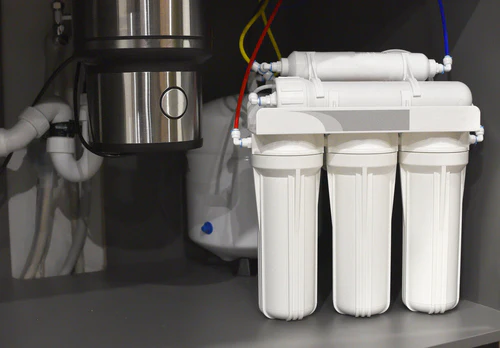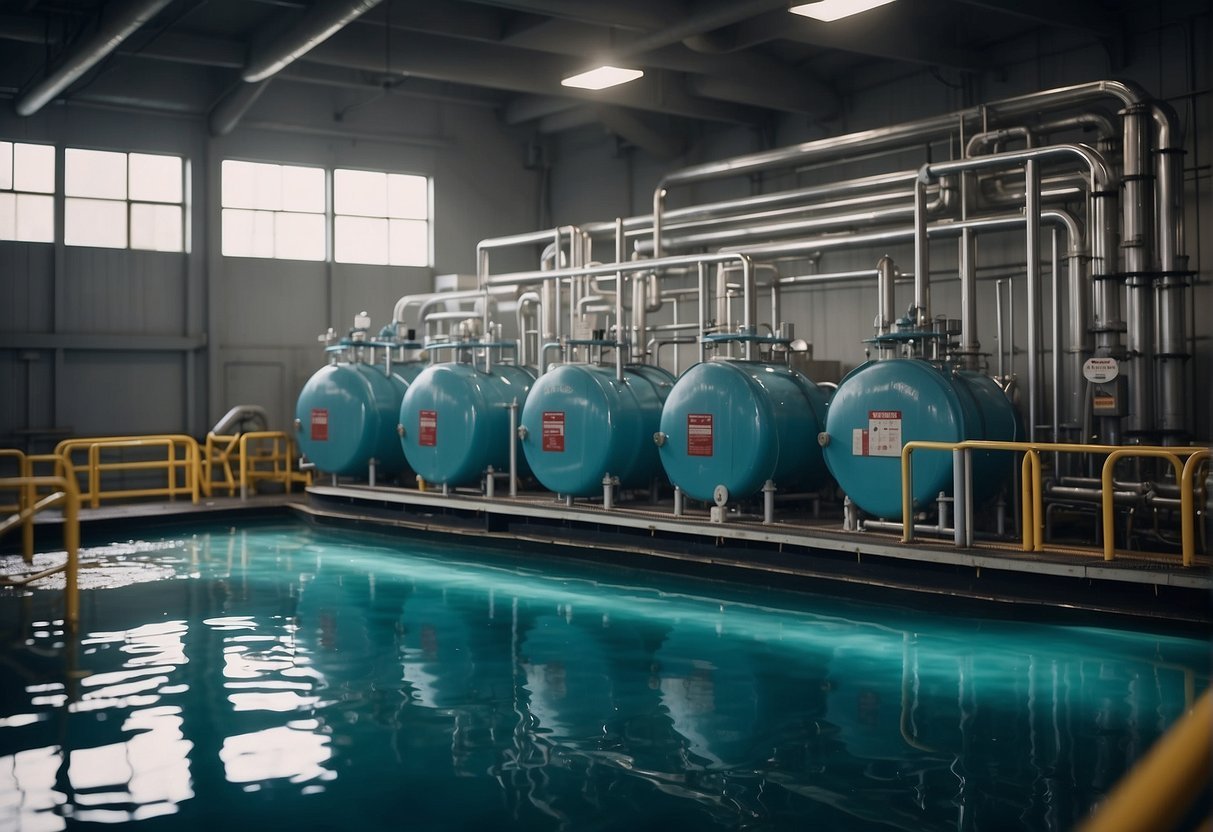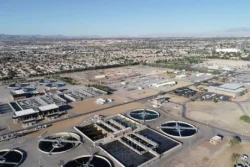Reverse Osmosis: Essential Guide to Water Purification

Reverse osmosis is a powerful and efficient method used to purify water by removing contaminants and impurities. Through the reverse osmosis process, water is forced through a semi-permeable membrane, allowing only clean water to pass through while blocking unwanted substances. This technology is widely used in both home and industrial settings to ensure safe, clean drinking water.
Different types of reverse osmosis systems are available, each tailored to specific needs, from small household units to large-scale industrial applications. These systems often include multiple stages of filtration, enhancing their effectiveness in removing various pollutants. This versatility makes reverse osmosis a beneficial solution for many water quality issues.
Proper installation and regular maintenance are crucial for the optimal performance of reverse osmosis systems. By understanding the economic aspects, health and safety considerations, and potential drawbacks, individuals and businesses can make informed decisions about using this water purification technology.
Key Takeaways
- Reverse osmosis removes contaminants through a semi-permeable membrane.
- Various reverse osmosis systems cater to different needs and applications.
- Regular maintenance is essential for system efficiency and longevity.
Fundamentals of Reverse Osmosis
Reverse osmosis (RO) is a technology used to purify water by removing contaminants and dissolved salts. This process relies on high-pressure pumps and specialized membranes to achieve clean water.
The Reverse Osmosis Process
Reverse osmosis works by pushing water through a semi-permeable membrane. Contaminants are left behind as clean water passes through.
- Pre-treatment: Water is pre-filtered to remove large particles and chlorine.
- Pressure Application: A high-pressure pump forces water through the RO membrane.
- Filtration: The semi-permeable membrane blocks contaminants like salts and impurities.
- Post-treatment: The filtered water may go through carbon filters to remove any remaining odors or tastes.
This system is capable of removing up to 99% of dissolved salts, bacteria, and other impurities. RO is essential in desalination and produces high-quality drinking water.
Key Components of RO Systems
RO systems consist of several key parts:
- Pre-filters: Remove large particles and protect the membrane.
- High-pressure pump: Essential for forcing water through the membrane.
- RO membrane: The core component that filters out contaminants.
- Post-filters: Provide additional purification, often using carbon.
- Storage tank: Holds clean water.
Each component plays a crucial role. The membrane’s effectiveness is vital for water purity. Pre-filters and post-filters extend the lifespan of the system and improve water quality. High-pressure pumps ensure water flows through the system efficiently, making the filtration process effective.
For more detailed information, check out this study on membrane desalination.
Types of Reverse Osmosis Systems
Reverse osmosis systems come in various forms tailored to different settings and needs. Each type has specific features and advantages, making it suitable for various applications, from household to commercial use.
Countertop RO Systems
Countertop RO systems are compact and easy to install. They don’t require any plumbing changes and can be placed on any kitchen counter. These systems are ideal for renters or those with a temporary setup.
Typically, countertop reverse osmosis systems connect directly to a standard faucet. They are portable and can be moved easily. Despite their size, they offer multiple stages of filtration, including pre-filters and post-filters, ensuring clean drinking water.
The best countertop reverse osmosis systems are highly efficient and often require minimal maintenance. They’re perfect for daily use and provide a cost-effective solution for clean water.
Under Sink RO Systems
Under-sink RO systems are perfect for those looking for a more permanent solution. These systems are installed under the kitchen sink and connected to the plumbing. They often include a separate faucet for dispensing purified water.
The top reverse osmosis systems for under-sink installation typically feature multiple filtration stages. These stages often include sediment filters, carbon filters, and RO membranes.
One key advantage of under-sink systems is their ability to filter large volumes of water. They are also discreet and don’t take up counter space. Installation might require professional help, but they offer long-term benefits.
Portable RO Systems
Portable RO systems are designed for those who need clean water on the go. These systems are small, lightweight, and easy to carry, making them suitable for travel, camping, or emergencies.
A portable reverse osmosis system often comes with quick-connect fittings, allowing it to be set up and broken down quickly. Despite their size, they provide multiple filtration stages.
These systems are highly convenient and can be a lifesaver in areas where water quality is questionable. They’re also useful for those living in rented spaces, as they don’t require any permanent installation.
Commercial RO Systems
Commercial RO systems are built to handle large volumes of water, making them suitable for businesses, factories, and large households. They are more robust and have higher capacity filters compared to household systems.
These systems often include advanced features like automated controls, pressure gauges, and more durable membranes. They are designed to provide consistent and reliable water purification.
The best reverse osmosis systems for commercial use can filter thousands of gallons per day. They are typically customized to meet specific water quality needs and often require professional installation and maintenance.
Tankless RO Systems
Tankless RO systems are a newer innovation in water purification technology. Unlike traditional systems, they don’t store filtered water in a tank. Instead, they filter water on demand, providing fresh water instantly.
These systems are more compact and often have a higher flow rate. They use advanced filtration technology and are more efficient in terms of water usage.
Tankless reverse osmosis systems are ideal for homes with limited space. They are easy to maintain and often come with smart features like filter replacement indicators. These systems provide a continuous supply of purified water without the need for a storage tank.
Stages of Filtration
Reverse Osmosis (RO) systems use a series of filtration stages to purify water. Each stage has a specific role in removing contaminants and improving water quality.
4-Stage RO Systems
A 4-stage reverse osmosis system includes the following stages:
- Sediment Filter: This initial stage removes large particles like dirt, sand, and rust. It protects later stages from clogging.
- Carbon Block Filter: It removes chlorine and other chemicals that can damage the RO membrane.
- RO Membrane: This semi-permeable membrane filters out tiny contaminants, including most dissolved solids, heavy metals, and pathogens.
- Post Carbon Filter: Often made of activated carbon, this final stage polishes the water, removing any remaining tastes or odors.
These stages collectively ensure the water is significantly purified and safe for drinking.
5-Stage RO Systems
A 5-stage reverse osmosis system enhances water purification with an additional stage:
- Sediment Filter
- Carbon Block Filter
- Granular Activated Carbon (GAC) Filter: This filter further removes chlorine and other organic compounds, enhancing the protection of the RO membrane.
- RO Membrane
- Post Carbon Filter
The addition of the GAC filter in 5-stage systems provides extra purification, helping to ensure the RO membrane operates efficiently and has a longer lifespan. For maintenance, 5-stage reverse osmosis replacement filters are necessary to keep the system running optimally.
6 and 7-Stage RO Systems
6 and 7-stage reverse osmosis systems introduce extra filters for additional benefits:
6-Stage RO System
- Sediment Filter
- Carbon Block Filter
- GAC Filter
- RO Membrane
- Post Carbon Filter
- Mineral Filter: This stage adds essential minerals back into the water, enhancing its taste and health benefits.
7-Stage RO System
- Sediment Filter
- Carbon Block Filter
- GAC Filter
- RO Membrane
- Post Carbon Filter
- Mineral Filter
- Ultraviolet (UV) Filter: This final stage provides extra sterilization, killing any remaining bacteria or viruses.
These additional stages in 6 and 7-stage systems offer purified water with improved taste and added health benefits, making these systems ideal for those seeking the highest quality drinking water.
Installation and Maintenance
Installing a reverse osmosis (RO) system and regular maintenance, including filter replacement, are crucial for ensuring clean and safe drinking water. These steps require attention to detail but can be accomplished with basic tools.
Installing an RO System
An RO system typically goes under the kitchen sink. First, gather essential tools like a drill, screwdriver, and wrench. Start by attaching the cold water line to the RO system’s inlet valve. Next, install the system’s outlet, which connects to a separate faucet mounted on the sink. Make sure all connections are tight to prevent leaks.
After installing the faucet, connect the drain line. This line disposes of the wastewater produced during the purification process. Secure the drain line above the U-bend in the sink’s plumbing to avoid potential water backup.
Finally, mount the storage tank, typically included with the system, parallel to the RO unit. Ensure enough space for filter access during maintenance. Prime the system by allowing water to flow through it for a few hours.
Filter Replacement and System Maintenance
Maintaining an RO system involves regular filter replacements. Most RO units have multiple stages, including pre-filters and post-filters. Pre-filters generally capture larger particles and chlorine. These should be replaced every 6-12 months to prevent clogging and ensure effectiveness.
The RO membrane, the system’s core component, needs replacement every 2-3 years. This membrane removes smaller contaminants, improving water quality. Post-filters, which polish the water before it reaches the faucet, also need periodic replacement, typically once a year.
Regularly check for leaks and inspect connections. Keeping a maintenance log with dates of filter changes and inspections can help manage this routine. Neglecting regular maintenance can lead to reduced water quality and system inefficiency.
Benefits and Drawbacks
Reverse osmosis (RO) water treatment has both positive and negative aspects. Understanding these can help individuals decide whether this technology meets their needs and preferences.
Advantages of RO Water
Reverse osmosis water treatment can effectively remove many contaminants. It can filter out particulates, bacteria, and viruses, making it a reliable method for producing clean drinking water. The EPA states that this process results in water free from most impurities.
Another significant benefit is the removal of chemicals like PFAS, which are difficult to eliminate using other methods. According to the EPA, RO systems are more than 90% effective at removing these harmful substances.
RO water is beneficial for people with compromised immune systems because it ensures the water is virtually free of pathogens. This makes it a safe choice for health-conscious individuals.
Potential Concerns with RO Water
One concern is that reverse osmosis water can be stripped of beneficial minerals like calcium and magnesium. This is a trade-off for its high purification capability. Some worry that long-term consumption of demineralized water may lead to health issues, though the evidence is mixed.
Another issue is wastewater production. RO systems can waste a significant amount of water; typically, three to four gallons are discarded for each gallon of purified water. This can be a drawback for places facing water scarcity.
The cost of maintaining an RO system can be high. Filters and membranes need regular replacement, which can add up over time. Despite these concerns, for many, the benefits outweigh the downsides, especially where water quality is a significant issue.
Comparative Analysis
Reverse osmosis (RO) is compared with various filtration methods and distilled water to highlight key differences in efficiency, cost, and application. This analysis will assist readers in understanding the pros and cons of each method.
RO vs Other Filtration Methods
RO involves pushing water through a semi-permeable membrane to remove impurities. In contrast, carbon filters use activated carbon to adsorb contaminants. RO is more effective at removing a wide range of pollutants, including dissolved salts and heavy metals, making it suitable for desalination.
Ultrafiltration (UF), another method, uses a membrane but typically filters out larger particles and some bacteria. While UF systems are cheaper and use less energy, they do not remove dissolved salts or smaller molecules as effectively as RO.
When compared to various methods, RO stands out for its comprehensive filtration. However, it requires more maintenance and higher initial costs. By understanding the strengths and limitations of each method, one can choose the best filtration system for their needs.
RO Water vs Distilled Water
Reverse osmosis water and distilled water are both purified, but their processes differ. Distillation involves boiling water to produce steam, which is then condensed back into liquid. This method effectively removes minerals and microorganisms.
RO filtration, on the other hand, forces water through a membrane to filter out contaminants. This makes RO effective against a wide range of impurities, including many that distillation can’t remove. RO water often retains some beneficial minerals, whereas distilled water is completely mineral-free.
In terms of taste, some prefer RO water for its slightly retained minerals, giving it a fresher taste compared to the flat taste of distilled water. Both methods have their uses, but RO is generally more practical for everyday drinking water, while distilled water is ideal for industrial applications where purity is crucial.
Health and Safety Considerations
Reverse osmosis (RO) systems play a pivotal role in providing clean water by removing various contaminants. Understanding the implications of mineral content and the efficiency in eliminating harmful substances is essential.
RO Water and Mineral Content
Reverse osmosis is effective at removing many dissolved substances from water, including beneficial minerals like calcium and magnesium. While this can make the water pure, it also means that the essential minerals present in natural water are lost.
One concern is that the lack of these minerals may lead to a deficiency if RO water is the sole drinking source. Using a remineralization filter can help restore beneficial minerals. RO systems do not generally remove fluoride or sodium unless specifically designed to do so.
However, having minerals removed can be a positive aspect for those needing to limit mineral intake, such as people with kidney disease. Ensuring a balanced diet with mineral supplementation may mitigate any adverse effects.
RO Systems and Contaminant Removal
Reverse osmosis systems are highly effective at removing various contaminants, ensuring the water is safe to drink. These systems can eliminate chemical pollutants including arsenic, lead, and chlorine. They are also efficient in removing harmful substances like PFAS and fluoride when equipped appropriately.
Bacteria and parasites are another critical concern, and RO systems are designed to filter them out. This makes RO-treated water particularly safe during outbreaks of waterborne diseases.
Additionally, reverse osmosis can cut down the presence of PFAS chemicals, which are known for their persistence in the environment and potential health risks. This comprehensive removal process addresses many health risks associated with contaminated water.
Economic Aspects
Reverse osmosis (RO) systems have specific costs and financial considerations. This section covers the cost analysis of these systems for various uses.
Cost Analysis of RO Systems
The initial cost of reverse osmosis systems varies depending on size and capacity. Residential systems typically range from $150 to $500, while commercial systems can cost $1,000 to $20,000 or more. Installation costs also vary; professional installation adds about $200 to $500 for residential setups.
Operational costs include electricity, replacement filters, and membranes. Filters need replacement every 6 to 12 months, costing $50 to $200 annually. Membranes, replaced every 2 to 3 years, can cost $100 to $300 each. Regular maintenance ensures efficiency and longevity.
Commercial systems might have higher operational expenses due to larger capacities and more complex installations. Energy costs can also add up, depending on the system’s usage and efficiency.
Overall, while initial and recurring costs can be significant, the benefits of improved water quality and long-term savings often justify the investment. Regular maintenance and efficient use can help manage these costs effectively.
Frequently Asked Questions
Reverse osmosis (RO) systems are used to filter water by removing a wide range of contaminants. This section addresses common questions on how they work, their health impacts, and other related concerns.
How does a reverse osmosis water filter work?
A reverse osmosis water filter works by pushing water through a semi-permeable membrane. This membrane blocks contaminants while allowing clean water to pass through. The system usually involves multiple stages of filtration, including sediment and carbon filters, which enhance the purity of the water.
What are the potential health impacts of drinking reverse osmosis water?
Drinking reverse osmosis water provides clean, contaminant-free water, which can be beneficial for overall health. However, it can also remove some essential minerals like calcium and magnesium. It's important to ensure that these minerals are replenished through diet or supplements.
What are the primary drawbacks of using a reverse osmosis system?
Reverse osmosis systems can be costly to install and maintain. They also produce a significant amount of wastewater, which can be a concern for water conservation. Additionally, they may remove essential minerals, which could impact the taste and nutritional value of the water.
Can reverse osmosis systems remove all impurities from water?
While reverse osmosis systems are highly effective at removing many contaminants, they do not eliminate all impurities. For example, some pesticides, solvents, and volatile organic compounds (VOCs) can still pass through the membrane. Supplementary filters may be required to handle these specific contaminants.
What factors affect the cost of installing a reverse osmosis system for a home?
The cost of installing a reverse osmosis system at home depends on several factors. These include the complexity of the system, the number of stages of filtration, and whether it's a point-of-use or whole-house system. Labor costs for installation and the ongoing cost of replacement filters also contribute to the overall expense.
How often should the filters in a reverse osmosis system be replaced?
Filters in a reverse osmosis system should typically be replaced every 6 to 12 months. The exact frequency depends on the quality of the incoming water, the usage rate, and the specific recommendations from the manufacturer. Regular filter replacement is crucial to ensure the system operates efficiently and effectively.



